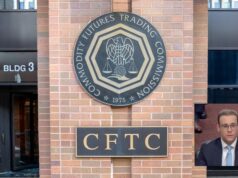President Donald Trump’s latest executive order aims to allow certain 401(k) alternative investments, including crypto and private equity, in default retirement options. Here’s how the plan works, the risks involved, and when changes could actually take effect.
Executive Order Overview
On August 7, 2025, President Donald Trump signed an executive order directing the Department of Labor (DOL) and the Securities and Exchange Commission (SEC) to craft new rules that would let specific 401(k) funds hold alternative assets, such as cryptocurrencies, private equity, private credit, real estate, commodities, and infrastructure.
The policy applies to default investment options, particularly target-date funds and balanced funds. That’s where the majority of American workers’ retirement savings are allocated by default. The White House describes the move as “democratizing access” to asset classes that have been historically reserved for institutional investors.
Implementation Timeline & Regulatory Process
Despite plenty of headlines about crypto in 401(k) plans, no changes take effect immediately. The executive order launches a 180-day review for the DOL and SEC to update ERISA guidance. They must define fiduciary duty boundaries, and potentially introduce safe-harbor provisions for plan sponsors.
New investment products, such as target-date fund alternatives that feature cryptocurrencies or private equity, would likely not appear until 2026 or later. Implementation will hinge on how regulators address valuation transparency, liquidity constraints, and fee disclosures.
Scale of Potential Impact
The U.S. 401(k) market holds about $9 trillion in assets for nearly 90 million participants. Even a modest 1% allocation to digital assets in default portfolios could drive billions of dollars in potential demand.
For asset managers, the shift could spark development of 401(k) alternative investments that blend public equities, bonds, and alternative sleeves into a single diversified product.
Supporters’ Perspective
Supporters celebrate the diversification of retirement accounts beyond traditional stock-bond mixes. Retail investors could gain exposure to assets with higher-return potential, such as private equity, through new 401(k) strategies. They claim it levels the playing field with institutional investors who already access these markets.
Critics’ Perspective
Critics caution that these new products may incur higher fees compared to index funds. Illiquidity in private markets can limit access to funds during downturns. They also argue that it is much harder to track the true performance of the new funds because valuations are more opaque. The volatility and regulatory uncertainty in the cryptocurrency markets add to the risks. Plan sponsors may expose themselves to legal challenges under ERISA if alternatives underperform.
Market Reaction in the Crypto Sector
Following the announcement, Bitcoin briefly surged, triggering an estimated $300 million in short liquidations before retreating. Obviously, traders assessed the long lead time for implementation.
Analysts note that exchange reserves are at multi-year lows and institutional holdings are rising. These are factors that could amplify price effects if significant 401(k) investment options become available in 2026 to include digital assets.
Parallel “Debanking” Executive Order
Alongside the 401(k) policy, the White House issued a second executive order targeting “politically motivated debanking.” It aims to prevent banks from denying services to lawful industries, including cryptocurrency businesses, based on reputational concerns.
What Savers Need to Know About Crypto in 401(k)
In short, there are no immediate changes. Monitor the DOL and the SEC for updates as they establish new rules. In the meantime, assess your personal risk tolerance for volatile or illiquid investments before you opt in. Even after the rule changes, plan sponsors may choose not to offer these products. Once these new 401(k) alternative investments appear, consult with financial advisors to evaluate whether these options fit with your long-term strategy and goals.
>>> Read more: Indirect Crypto Exposure: How Index Funds Tie You to Bitcoin
Bottom Line
Trump’s executive order signals a major potential shift in how 401(k) investment options could evolve, introducing assets once reserved for institutional portfolios. The outcome will depend on upcoming rulemaking, market innovation, and whether plan sponsors embrace or reject alternatives like crypto in 401(k) funds.
Until then, the debate over whether these investments belong in default retirement plans is set to dominate both Wall Street and Washington.
Readers’ frequently asked questions
Will my 401(k) automatically invest in crypto or private equity now?
No. The executive order only starts a 180-day review process for the Department of Labor and the SEC to update rules. Any new options must first be approved and added by your plan sponsor.
How would crypto or private equity appear in my 401(k)?
If approved, exposure would most likely come through diversified funds — such as target-date or balanced funds — that include a small percentage of alternative assets, rather than direct purchases of Bitcoin or private equity stakes.
What risks should I know before investing in these assets?
Alternative assets can involve higher fees, limited liquidity, harder-to-value holdings, and — in the case of cryptocurrencies — price volatility. These risks can affect long-term returns and should be weighed carefully before opting in.
What Is In It For You? Action items you might want to consider
Monitor the DOL and SEC rulemaking process
Follow announcements over the next 180 days to understand how regulators will define fiduciary standards and safe-harbor rules for alternative assets in 401(k) plans.
Review your plan’s investment menu
Check if your 401(k) provider or employer offers target-date or balanced funds that might adopt alternative assets once rules change. This will help you prepare for possible new options.
Evaluate your risk tolerance and retirement goals
Before considering allocations to crypto, private equity, or other alternatives, assess how these fit your time horizon, volatility comfort level, and long-term retirement objectives.










